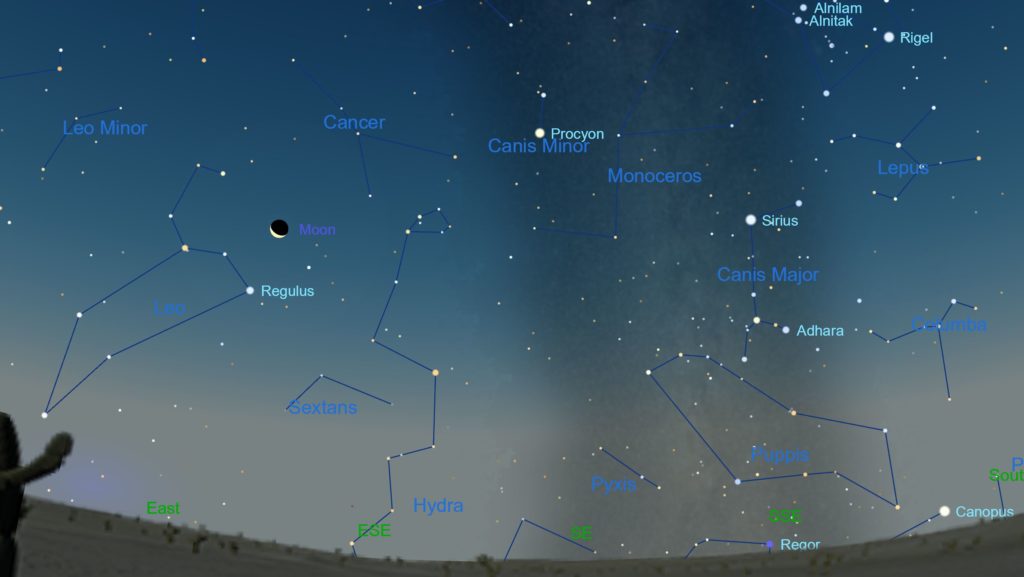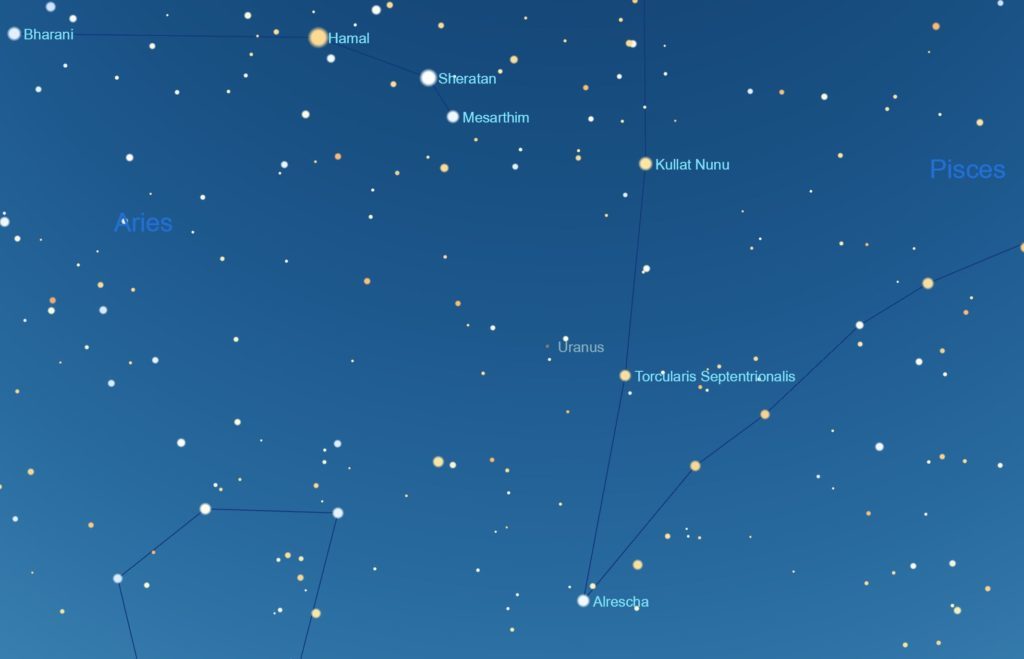A Orionid meteor. Image credit: Jeff Sullivan via Flickr.October is generally a great month for stargazing. The Milky Way still lingers in the west along with stars that were prominent in the northern summer. The autumn stars dominate overhead, and the northern winter stars are starting to poke above the eastern horizon. Best of all, you can get in a good night of stargazing without staying up too late. This year, the planets Jupiter, Saturn, and Mars, which have dazzled stargazers for months, are finally moving out of view for the year. There are a couple of meteor showers, the Moon twice brushes by a famous star cluster, and the planet Uranus reaches opposition in the constellation Aries. Here’s what to see in the night sky this month…
2 October. Last Quarter Moon, 09:45 UT
4 Oct. The waning crescent Moon hovers just over one degree south of the Beehive star cluster (Messier 44) in the eastern pre-dawn sky. It will be a lovely display in binoculars. This conjunction will repeat itself on October 31.
5 Oct. Since yesterday, the Moon has moved eastward along the ecliptic and now rises with the majestic constellation Leo, the Lion, just two fingerwidths south of its brightest star Regulus.

8 Oct. The Draconid meteor shower peaks over the next few days. This meteor shower occurs each year when the Earth passes through a stream of debris left from periodic Comet Giacobini-Zinner. While it’s usually a spartan meteor shower, with just a handful of meteors visible each hour, the Draconids have flared up from time to time. In 1933 and 1946, observers reported thousands of meteors per hour, so this modest shower became a meteor storm. There was also a good show in 1988. There’s no word of a flare up this year, but if you’re out stargazing, take a look. You never know.
9 Oct. New Moon, 03:47 UT
11 Oct. Jupiter is just three finger-widths south of a slender waxing crescent Moon. The biggest planet had a splendid apparition this year, but it’s on its way out until next year. The planet spans about 32”, still bigger than Mars ever gets, but it’s too low over the horizon to offer much detail in a telescope. Still, at magnitude -1.7, Jupiter still far outshines every star in the sky.
12 Oct. From now until the end of the month, northern-hemisphere observers who have very dark sky can see the zodiacal light in the eastern sky about 90-120 minutes before sunrise in the northern hemisphere. This whitish glowing wedge of light appears to thrust upward from the horizon. The zodiacal light, sometimes called the “False Dawn”, is simply sunlight reflected off tiny dust particles in the inner solar system.

14 Oct. Saturn is a little less than 2 degrees south of the crescent Moon in the southwestern sky after sunset. The pair is just north of the ‘Teapot’ of Sagittarius. Like Jupiter, Saturn had a fine apparition this year. The planet has grown smaller since its opposition in late June, but you can still spy its rings in a small telescope. The planet shines at a respectable magnitude +0.6, brighter than any star in the same part of the sky. By mid-October, the planet sets by about 10 p.m., and this is the last month you can see Saturn before it sets for the year. As you look at the planet, turn also to Jupiter to the west and red-orange Mars to the east to take in one last time the fourth, fifth, and sixth most distant planets from the Sun.
16 Oct. First Quarter Moon, 18:02 UT
18 Oct. Mars is just two finger widths south of the gibbous Moon in the south. Mars put on a spectacular show this year, especially for southern observers, but the planet is quickly growing smaller and fainter. It is, however, still plenty bright enough to attract attention. As the month begins, Mars shines at magnitude -1.3, and remains the brightest object in the southern part of the sky. By the end of October, it fades to magnitude -0.6. Its apparent size drops from 16” to 12” during the month compared to a grand 24” across at opposition at the end of July. You will be challenged to see much detail on the planet with a telescope, but enjoy the spectacle of the planet fading and moving eastward each night through Capricornus.
20-22 Oct. Look for the Orionid meteor shower in the early morning hours. One of the finest of all meteor showers, the Orionids present perhaps 20-40 fast-moving meteors per hour in dark sky. The radiant of the Orionids is near the club of Orion, but you can see the meteors anywhere in the sky in both hemispheres. Just look up anywhere and start watching. Early morning, from 3 a.m. local time through dawn, is the best time to observe the shower. This year, unfortunately, the light from the waxing Moon may wash out some of the fainter meteors, especially before midnight. Like the Aquariid meteors in May, the Orionid meteors are bits of Comet Halley that hit the upper atmosphere as the Earth passes through the debris field of the comet.

23-24 Oct. The planet Uranus reaches opposition today, rising in the east as the Sun sets in the west. The planet is just 3.7″ across in a telescope and it shines at magnitude 5.7, bright enough to see without optics if you know where to look. Through the end of the month, you’ll get the best view of the planet around midnight. Uranus lies in the southwestern part of the constellation Aries just east of the star Omicron Piscium (Torcularis Septentrionalis).
24 Oct. Full Moon, 16:45 UT
26 Oct. Looking for Venus? Don’t bother. Today, the planet reaches inferior conjunction, the point at which it’s on the same side of the Sun as Earth and lost in the Sun’s glare. Moving forward, the planet will slowly emerge in the pre-dawn sky and become the “Morning Star” for the next several months.
26 Oct. Look for the waning gibbous Moon next to the Hyades star cluster in the constellation Taurus in the in the late evening hours through dawn.
